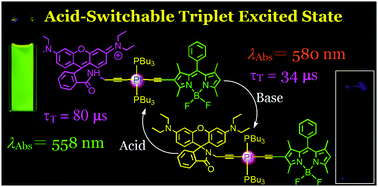Switching of the photophysical properties of Bodipy-derived trans bis(tributylphosphine) Pt(ii) bisacetylide complexes with rhodamine as the acid-activatable unit†
Abstract
A rhodamine moiety was used for the preparation of trans bis(tributylphosphine) Pt(II) bisacetylide complexes (RH-BDPY-Pt-1 and RH-BDPY-Pt-2, with two different Bodipy acetylide ligands), which show acid/base-switchable photophysical properties. The rhodamine moiety undergoes reversible spirolactam ↔ opened amide structure transformation in the presence of an acid/base. Bodipy ligands are responsible for strong visible light-harvesting. The photophysical properties of the Pt(II) complexes were studied with steady state UV–Vis absorption, luminescence spectra, nanosecond transient absorption spectroscopy, electrochemical characterization and DFT/TDDFT computations. In the absence of an acid, the complexes show the absorption of Bodipy ligands at 580 nm and 500 nm, respectively. Both complexes show fluorescence. A minor phosphorescence band was observed for RH-BDPY-Pt-1. In the presence of trifluoroacetic acid (TFA), the spirolactam → opened amide transformation occurred and the absorption of the rhodamine moiety at 570 nm appeared; colour changes were observed for the solutions of the complexes. Moreover, the fluorescence of the complexes was switched on. Long-lived triplet excited states were observed for the two complexes (35 μs and 423 μs, respectively, in dichloromethane). Upon the addition of TFA, the triplet state lifetime of RH-BDPY-Pt-1 was substantially prolonged to 80 μs from 35 μs (the triplet state of RH-BDPY-Pt-1 is localized on the Bodipy moiety); for RH-BDPY-Pt-2, however, the triplet state is switched from the Bodipy-confined triplet state to a triplet state delocalized on the Bodipy and rhodamine moiety. Thus both the singlet excited state and the triplet state of the Pt(II) complexes were switched upon the addition of an acid. The photophysical properties were rationalized with DFT/TDDFT calculations. These results on tuning of the photophysical properties of Pt(II) complexes with a rhodamine moiety may be useful for designing external stimuli-activatable transition metal complexes.


 Please wait while we load your content...
Please wait while we load your content...